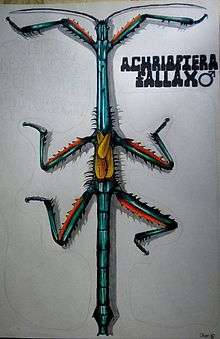Achrioptera fallax
Achrioptera fallax is a stick insect species found in Madagascar.
| Achrioptera fallax | |
|---|---|
 | |
| Male Achrioptera fallax | |
| Scientific classification | |
| Kingdom: | Animalia |
| Phylum: | Arthropoda |
| Class: | Insecta |
| Order: | Phasmatodea |
| Family: | Phasmatidae |
| Genus: | Achrioptera |
| Species: | A. fallax |
| Binomial name | |
| Achrioptera fallax Coquerel 1861 | |
Description
The males are a bright electric blue (with greenish tints) and have two rows of reddish orange spines along the edges of the femur. There are also dark coloured spines going along the sides and underneath the thorax. Males are brachypterous (incapable of flight) and have small reduced wings. The forewings are a bright yellow; the hind wings have a yellow ridge and are primarily red with a black centre. The male’s abdomen tip finishes like a club tail. The 7th and 8th tergum (abdominal segments) both extend outwards along the sides giving it the gradual shape of a hexagon. The 9th tergite is like the rest of the abdomen but has a pair of cerci for mating. Cerci are like claspers (which dragonflies possess) that help the male get a grasp of the female during copulation. Females have a duller outlook. They are a light brown with red spines covering the entire thorax and the top of the head. (Males have an absence of spines on the head). The femur has spines on the edges but not colourful like the males. There are a few patches of light cyan on the coxa, the inner part of the femur and sometimes the head. The female is also brachypterous. The only difference separating her from the male is that the yellow pigment on the wings is not at all as pronounced. The female’s abdomen ends in a point (because of her ovipositor) rather than finishing like a club. Both male and female possess white-ish stripes along the top and sides of the head. The male grows up to 13 cm in length while the female is much bigger and can grow up to 18, 5 cm in length.
Diet
Their diet in the wild is unknown but in captivity they mainly feed on bramble, raspberry, eucalyptus, and oak.
Reproduction
Both sexes of the A. fallax are required to reproduce. The female lays eggs in the soil. These eggs are then incubated in between six and nine months.
Temperature: In captivity for adults, the temperature should be in between 24C to 28C. For eggs, the temperature should be around 18C to 25C. The ova that are in the soil should be sprayed with water once daily.
Humidity: The humidity should be from 50% to 60%. The cage should be well ventilated A damp cloth at the bottom of the cage is recommended in order to keep moisture in the phasmid’s surroundings. If there isn’t enough moisture, the phasmid could have trouble moulting (breaking through its old skin) and could possibly die.
Life span: Based on captive bred experience lifespan around 8-10 months from hatching - around 3-4 months as adults. Longevity in the wild not known.